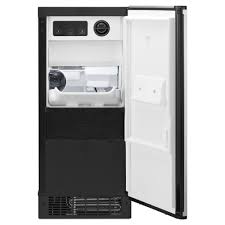Many customers report general satisfaction with Kenmore refrigerators, especially the Elite series. However, one common issue is with the ice maker. This guide will help you troubleshoot and resolve frequent problems, including the ice maker not turning on, failing to produce or dispense ice, being slow, leaking, freezing up, overflowing, or not filling properly. We’ll also address concerns like smaller, discolored, or strange-tasting ice.
By following the steps outlined in this guide, you can often fix most Kenmore ice maker issues yourself, potentially avoiding the need for a professional unless the problem is particularly complex.
We will also cover how to reset your Kenmore ice maker, which can solve some issues and is essential after certain component replacements.

Kenmore Ice Maker Troubleshooting
Ice Maker Won’t Turn On If your Kenmore ice maker is not powering on, start by checking if the refrigerator’s child lock feature is engaged, as this may prevent the ice maker from functioning. If that’s not the issue, the ice maker itself might have faulty components. Unplug the fridge, remove the ice bucket, and follow the manufacturer’s instructions to access and, if needed, replace the ice maker.
Water Inlet Valve Issue The ice maker and water dispenser receive water through an inlet valve typically located behind the fridge. Before you begin, unplug the refrigerator and shut off the water supply. Check the screen and water filter for blockages, and inspect the valve’s water line for any restrictions. If the water pressure is below 20 psi or if the solenoids are malfunctioning, the ice maker won’t receive water. You can use a multimeter to test the solenoid coils to determine if the valve needs replacement.
Ice Maker Temperature is Too High If your ice maker is not producing ice, it might be due to a temperature issue. Ice makers need the freezer temperature to be between 0 to 5 degrees Fahrenheit (-18 to -15 degrees Celsius). If it exceeds 10 degrees Fahrenheit (-12 degrees Celsius), ice production may cease. Check for dust on the coils, ensure the condenser fan is operational, and inspect for frost buildup on the evaporator coils, which could indicate a defrost system problem.
Broken Door Switch A malfunctioning door switch may cause ice maker issues by incorrectly detecting that the fridge door is open. To resolve this, unplug the fridge, locate the door switch, and inspect it for damage. Replace the door switch with a compatible part if necessary.
Ice Maker Won’t Make Ice If your ice maker isn’t producing ice, check the freezer temperature, water supply, and water filter. A clogged filter or a damaged door gasket can hinder ice production. Use a multimeter to test the ice maker switch and mold thermostat for faults. If these checks don’t resolve the issue, examine the ice level control board and water inlet valve for potential problems.
Frosted Evaporator Coils Frost buildup on the evaporator coils can impact ice production. Ensure the freezer temperature is between 0 to 5 degrees Fahrenheit (-18 to -15 degrees Celsius), check the door gasket for damage, and assess the defrost system. A malfunction in the defrost system can prevent proper ice maker function.
Low Water Pressure or Water Supply Issue For issues related to low water pressure or water supply, make sure the water supply is turned on and the water line isn’t blocked. A clogged water filter or a faulty inlet valve may restrict water flow. Verify that the water pressure is above 20 psi, and replace the inlet valve if necessary.
Ice Maker Won’t Dispense Ice If your ice maker isn’t dispensing ice, check the ice chute for clogs that could be obstructing ice flow. A frozen auger motor can also prevent ice dispensing. Test the thermostat to ensure it’s accurately monitoring the ice bin’s temperature.
Smaller Ice Cubes Small ice cubes may result from low water pressure or an incorrect freezer temperature. Ensure the water supply valve is fully open and the freezer is set between 0 to 5 degrees Fahrenheit (-18 to -15 degrees Celsius).
Dirty/Discolored Ice Discolored or dirty ice can be caused by a faulty water inlet valve or a dirty ice mold tray. Replace the valve if necessary and clean the mold tray to remove mineral deposits. Check the water supply line for contaminants and replace it if needed.
Kenmore Refrigerator Control Board Issue A malfunctioning control board can affect the ice maker’s functionality. Signs of a control board issue include unusual temperature fluctuations or unresponsive display panels. If you suspect the control board, consult the user manual for instructions on resetting or troubleshooting.
Kenmore Refrigerator Water Filter Issue A clogged water filter can reduce water flow and impact ice quality. Replace the filter according to the manufacturer’s recommendations and ensure compatibility with your refrigerator model. After replacement, run a few cycles of water to flush the new filter.
How to Reset the Ice Maker on a Kenmore Refrigerator
To reset the ice maker, locate the control switch or button on the ice maker assembly and hold it for 10 seconds. After releasing the button, wait a few minutes for the ice maker to reset and resume operation.
Conclusion
This troubleshooting guide provides detailed steps for diagnosing and fixing common Kenmore ice maker issues. By following these tips, you can often resolve problems yourself. For more complex issues, it’s advisable to seek assistance from a technician specializing in Kenmore appliances. Always remember to disconnect power and water supplies before performing any repairs.
Related Posts
Marvel Ice Maker Troubleshooting | Easy Step’s
Costway Ice Maker Troubleshooting | Easy Steps
Silonn Ice Maker Troubleshooting – 14 Easy Steps
